

Compact Muon Solenoid
LHC, CERN
| CMS-PAS-HIG-16-002 | ||
| Search for resonant pair production of Higgs bosons decaying to two bottom quark-antiquark pairs in proton-proton collisions at 13 TeV | ||
| CMS Collaboration | ||
| March 2016 | ||
| Abstract: A model-independent search for a narrow-width resonance decaying into two Higgs bosons, each having a mass of 125 GeV and decaying into a $\mathrm{b\bar{b}}$ pair, is presented. The search is performed using proton-proton collision data corresponding to an integrated luminosity of 2.3 fb$^{-1}$ at $\sqrt{s} = $ 13 TeV recorded by the CMS detector at the LHC. No evidence for a signal is observed and upper limits at a 95% confidence level on the production cross section for such a resonance, in the mass range from 260 to 1200 GeV, are set. | ||
| Links: CDS record (PDF) ; inSPIRE record ; CADI line (restricted) ; | ||
| Figures & Tables | Summary | Additional Figures | CMS Publications |
|---|
| Figures | |

png pdf |
Figure 1:
Illustration of SR and SB in the ($m_{\mathrm{H}1}$, $m_{\mathrm{H}2}$) plane used to motivate and validate the parametric model for the QCD multijet background. The quantities $m_{\mathrm{H}1}$ and $m_{\mathrm{H}2}$ are the two reconstructed Higgs boson masses after b-tagging and kinematic selections for data in medium-mass region. |
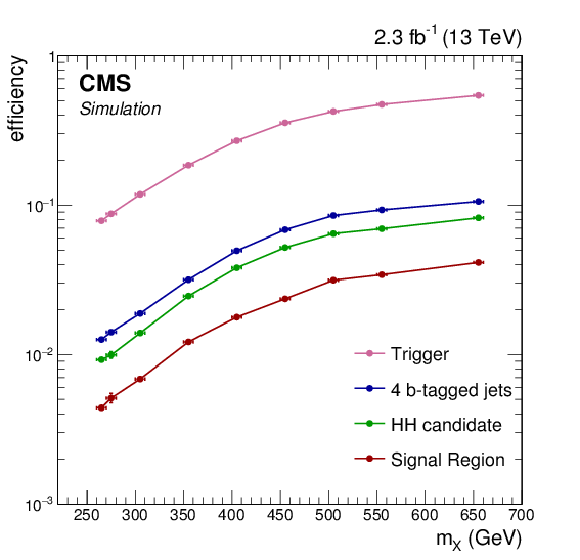
png pdf |
Figure 2-a:
The selection efficiency for simulated ${\mathrm {X}\to \mathrm {H}(\mathrm {b}\bar{\mathrm {b}})\mathrm {H}(\mathrm {b}\bar{\mathrm {b}})}$ events (X is a spin-2 RS1 KK-Graviton) at different stages of the event selection for each mass hypothesis, for the low-mass region (a) and the medium-mass region (b). |
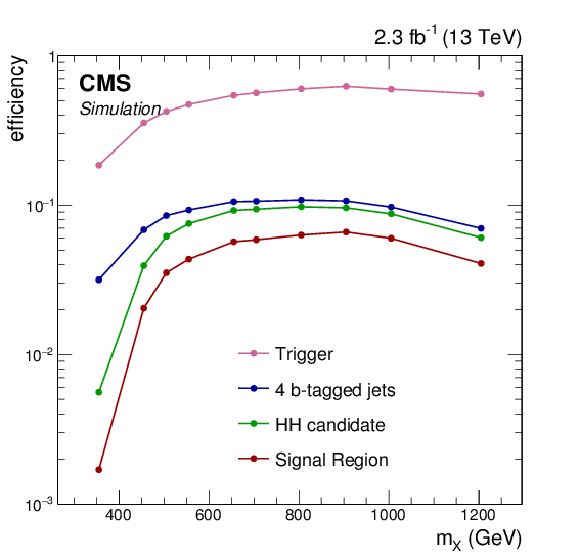
png pdf |
Figure 2-b:
The selection efficiency for simulated ${\mathrm {X}\to \mathrm {H}(\mathrm {b}\bar{\mathrm {b}})\mathrm {H}(\mathrm {b}\bar{\mathrm {b}})}$ events (X is a spin-2 RS1 KK-Graviton) at different stages of the event selection for each mass hypothesis, for the low-mass region (a) and the medium-mass region (b). |
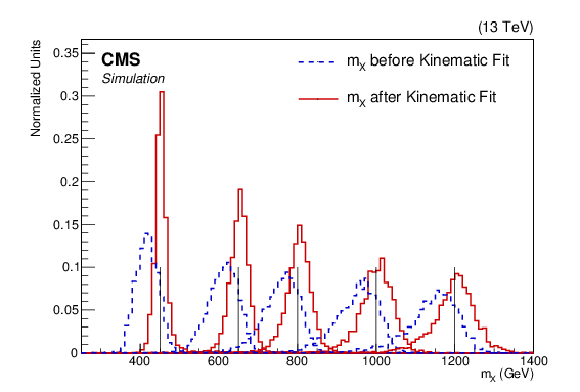
png pdf |
Figure 3:
The $m_{\mathrm{X}}$ distribution of signal simulated events (spin-2 RS1 KK-Graviton) after the event selection criteria for each of mass hypothesis, with and without the correction by the kinematic constraint to $m_{\mathrm{H}}$. |
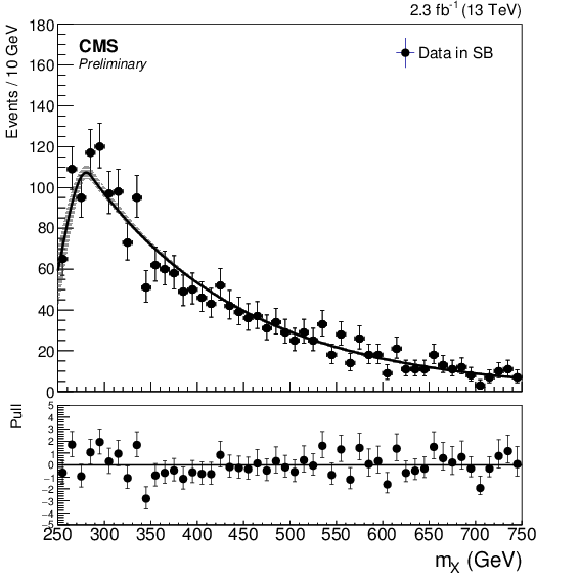
png pdf |
Figure 4:
The $m_{\mathrm{X}}$ distributions in data in the Signal Region Sideband (SB) of the low-mass region. The distributions are fitted to the GaussExp function and the shaded regions correspond to 1$\sigma $ variations of the parametrized form. |
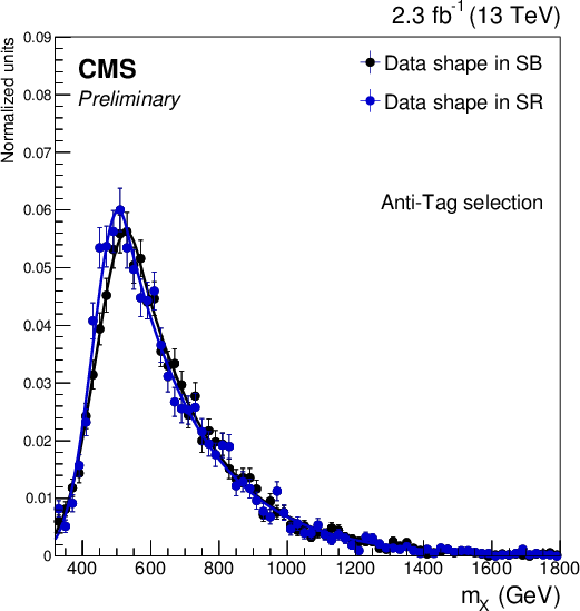
png pdf |
Figure 5:
The $m_{\mathrm{X}}$ distributions in the control region of data where one of the four jets is required to not be a b-jet. The fits in the SR and SB regions of the medium-mass region are presented. |

png pdf |
Figure 6-a:
The $m_{\mathrm{X}}$ distribution in the Signal Region (SR) of data in the LMR (a) and the MMR (b). A fit to the background-only hypothesis, which consists of the QCD multi-jet shape is shown. The shaded region corresponds to a $\pm $1$\sigma $ variation of this parametrized form. The number of degrees of freedom ($n$) corresponds to the number of fit parameters (4) subtracted from the number of bins in the histogram. |
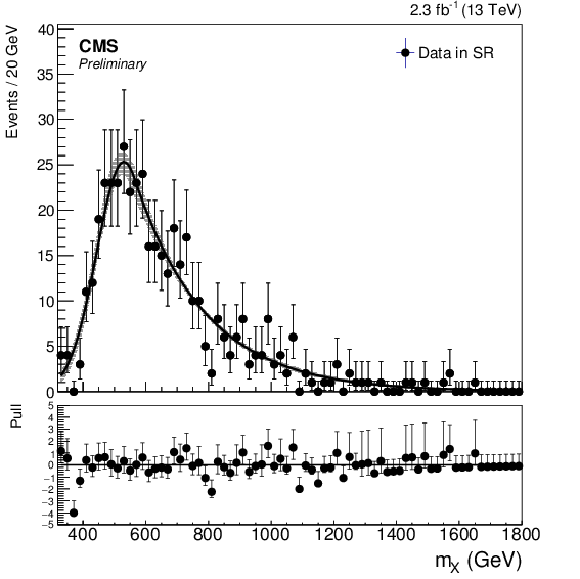
png pdf |
Figure 6-b:
The $m_{\mathrm{X}}$ distribution in the Signal Region (SR) of data in the LMR (a) and the MMR (b). A fit to the background-only hypothesis, which consists of the QCD multi-jet shape is shown. The shaded region corresponds to a $\pm $1$\sigma $ variation of this parametrized form. The number of degrees of freedom ($n$) corresponds to the number of fit parameters (4) subtracted from the number of bins in the histogram. |
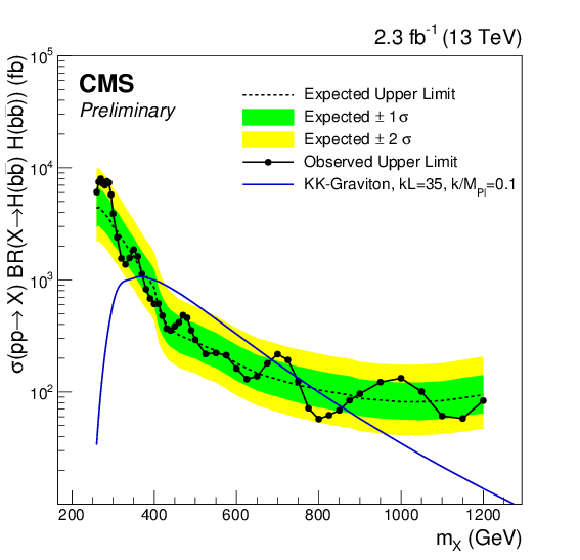
png pdf |
Figure 7:
The observed and expected upper limits on the cross section for a spin-2 resonance ${\mathrm {X}\to \mathrm {H}(\mathrm {b}\bar{\mathrm {b}})\mathrm {H}(\mathrm {b}\bar{\mathrm {b}})}$ at a 95% confidence level using data corresponding to an integrated luminosity of 2.3 fb$^{-1}$ at $\sqrt {s} = $ 13 TeV using the asymptotic CL$_S$ method. Theoretical cross sections for the RS1 KK-Graviton, with $k/M_{\text{Pl}}= $ 0.1, $kL = $ 35, decaying to four b-jets via Higgs bosons are overlaid. |
| Tables | |

png pdf |
Table 1:
Impact of systematic uncertainties on the signal efficiencies in the low-mass region (LMR) and the medium-mass region (MMR). |
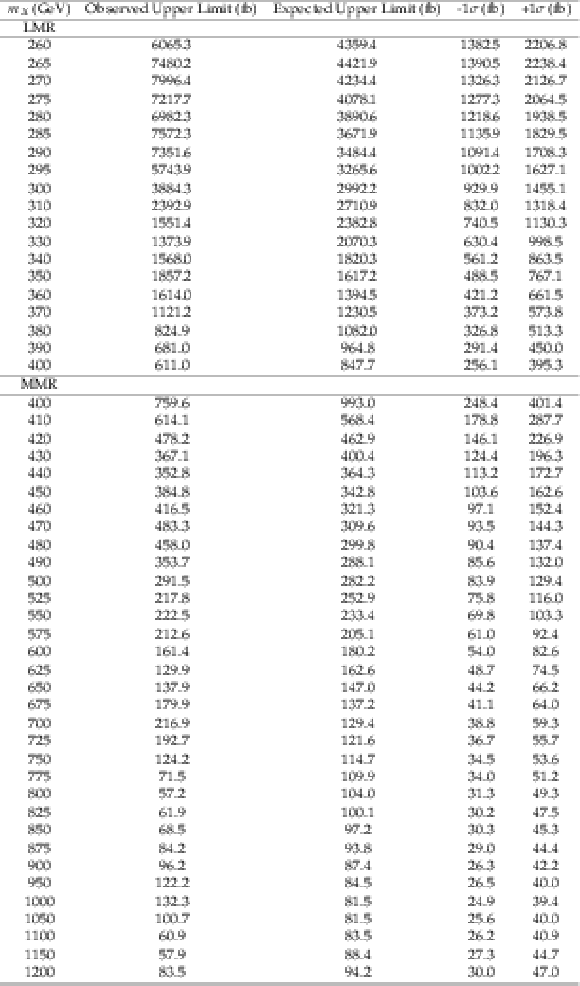
png pdf |
Table 2:
The observed and expected upper limit of $\sigma (pp \to {\mathrm {X}\to \mathrm {H}(\mathrm {b}\bar{\mathrm {b}})\mathrm {H}(\mathrm {b}\bar{\mathrm {b}})})$ at a 95% confidence level using 2.3 fb$^{-1}$ of data for the low and medium-mass regimes (LMR and MMR). |
| Summary |
| A model-independent search for a narrow-width resonance is presented. No evidence for a signal is observed in the explored mass range between 260 GeV and 1200 GeV. According to these results the RS1 KK-Graviton with $kL= $ 35 , $k/M_{\text{Pl}}= $ 0.1 and mass above 350 GeV and below 725 GeV, and in the 775-850 GeV mass range is excluded at a 95% confidence level. A similar search, exploiting 17.9 fb$^{-1}$ collected at 8 TeV, has comparable sensitivity [5] and excluded the same model in the 380-800 GeV mass range. |
| Additional Figures | |
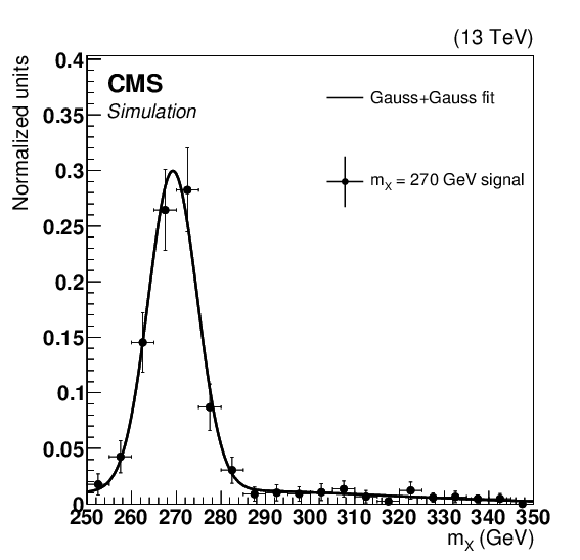
png pdf |
Additional Figure 1:
A maximum likelihood fit to the $m_{\mathrm{X}}$ distribution of simulated signal events for the 270 GeV mass hypothesis that pass the low-mass region selection criteria. The distribution is fitted to the sum of two Gaussians. Here n is the number of degrees of freedom in the fit. |
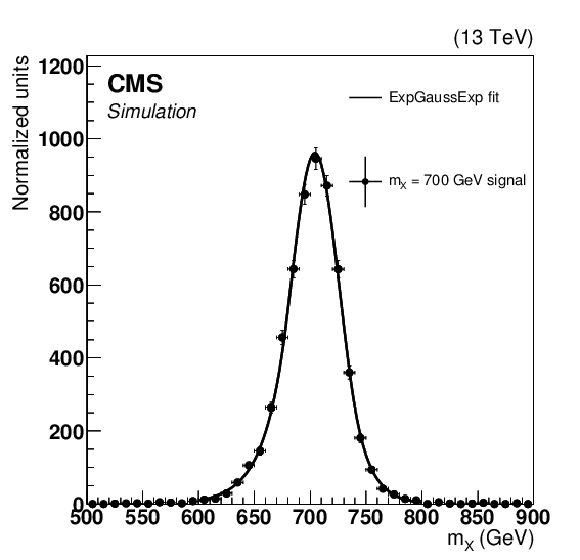
png pdf |
Additional Figure 2:
A maximum likelihood fit to the $m_{\mathrm{X}}$ distribution of simulated signal events for the 700 GeV mass hypothesis that pass the medium-mass region selection criteria. The distribution is fitted to a Gaussian core smoothly extended on both sides to exponential tails. Here n is the number of degrees of freedom in the fit. |
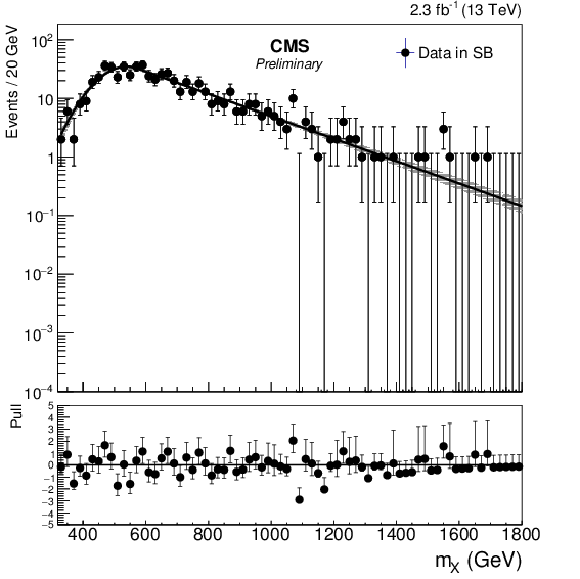
png pdf |
Additional Figure 3:
The $m_{\mathrm{X}}$ distributions in data in the Signal Region Sideband (SB) of the medium-mass region. The distributions are fitted to the GaussExp function and the shaded regions correspond to 1$\sigma $ variations of the parametrized form. |

png pdf |
Additional Figure 4:
The $m_{\mathrm{X}}$ distributions in the control region of data where one of the four jets is required to not be a b-jet. Presented are fits in the SR and SB regions of the low-mass region. All distributions are fitted to the GaussExp function and the shaded regions correspond to 1$\sigma $ variations of the parametrized form. |

png pdf |
Additional Figure 5:
The observed and expected upper limits on the cross section for a spin-0 resonance ${\mathrm {pp}\to \mathrm {X}\to \mathrm {H}(\mathrm {b}\bar{\mathrm {b}})\mathrm {H}(\mathrm {b}\bar{\mathrm {b}})}$ at a 95% confidence level using data corresponding to an integrated luminosity of 2.3 fb$^{-1}$ at $\sqrt {s} =$ 13 TeV using the asymptotic CL$_S$ method. Theoretical cross sections for the RS1 radion, with $\Lambda _R =$ 1 TeV , $kL =$ 35, decaying to four b-jets via Higgs bosons are overlaid. |

|
Compact Muon Solenoid LHC, CERN |

|

|

|

|

|

|